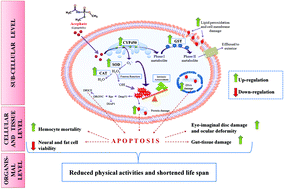当前位置:
X-MOL 学术
›
Toxicol. Res.
›
论文详情
Our official English website, www.x-mol.net, welcomes your
feedback! (Note: you will need to create a separate account there.)
Chronic exposure to acephate triggers ROS-mediated injuries at organismal and sub-organismal levels of Drosophila melanogaster
Toxicology Research ( IF 2.2 ) Pub Date : 2018-05-04 00:00:00 , DOI: 10.1039/c8tx00052b Prem Rajak 1 , Salma Khatun 2 , Moumita Dutta 2 , Moutushi Mandi 2 , Sumedha Roy 2
Toxicology Research ( IF 2.2 ) Pub Date : 2018-05-04 00:00:00 , DOI: 10.1039/c8tx00052b Prem Rajak 1 , Salma Khatun 2 , Moumita Dutta 2 , Moutushi Mandi 2 , Sumedha Roy 2
Affiliation

|
The present study demonstrates ROS-mediated organismal and sub-organismal injuries in Drosophila melanogaster following chronic acephate exposure. Larvae and adults of Drosophila were reared on food supplemented with sub-lethal concentrations (1–6 μg mL−1) of acephate (LC50 8.71 μg mL−1). The longevity of the treated adults was reduced to half at 6 μg mL−1 exposure along with declined neuromuscular coordination and physical activities. Apparent developmental defects in the compound eyes were confirmed through the detection of apoptotic lesions in larval eye imaginal discs. The larval gut manifested tissue damage at various sites. Neural and fat cell viability was reduced by ∼1.89- and ∼3.38-fold at 6 μg mL−1 acephate treatment, respectively. A significant reduction in hemocyte viability confirmed the immunotoxic potential of acephate. Nearly 1–3-fold enhancement in the expression of OS markers (MDA, protein carbonyl contents, SOD, catalase and HSP70) in the treated larvae served as evidence of ROS production. The post-treatment increase in CYP450 and GST activities reflects the ‘switch-on’ states of the phase-I and phase-II detoxification mechanism. The genotoxic potential of acephate was confirmed through alkaline single cell gel electrophoresis. Thus, the findings of the present study validate the fact that besides traditional cholinesterase inhibition, chronic sub-lethal exposure to acephate potentially induces ROS-mediated toxic responses in Drosophila.
中文翻译:

长期接触乙酰甲胺磷会在黑腹果蝇的有机体和亚有机体水平上引发ROS介导的损伤
本研究表明,黑腹果蝇在长期接触乙酰甲胺磷后,会出现活性氧介导的有机体和亚有机体损伤。果蝇幼虫和成虫饲养在添加了亚致死浓度(1-6 μg mL -1)乙酰甲胺磷(LC 50 8.71 μg mL -1)的食物中。在 6 μg mL -1暴露下,接受治疗的成年人的寿命缩短一半,同时神经肌肉协调性和身体活动下降。通过检测幼虫眼成虫盘中的凋亡病变,证实了复眼的明显发育缺陷。幼虫肠道的多个部位均出现组织损伤。在 6 μg mL -1乙酰甲胺磷处理下,神经细胞和脂肪细胞活力分别降低~1.89 倍和~3.38 倍。血细胞活力的显着降低证实了乙酰甲胺磷的免疫毒性潜力。经处理的幼虫中 OS 标记物(MDA、蛋白质羰基含量、SOD、过氧化氢酶和 HSP70)的表达增加了近 1-3 倍,这是 ROS 产生的证据。治疗后 CYP450 和 GST 活性的增加反映了 I 期和 II 期解毒机制的“开启”状态。通过碱性单细胞凝胶电泳证实了乙酰甲胺磷的潜在遗传毒性。因此,本研究的结果证实了这样一个事实:除了传统的胆碱酯酶抑制作用外,长期亚致死暴露于乙酰甲胺磷可能会诱导果蝇中ROS介导的毒性反应。
更新日期:2018-05-04
中文翻译:

长期接触乙酰甲胺磷会在黑腹果蝇的有机体和亚有机体水平上引发ROS介导的损伤
本研究表明,黑腹果蝇在长期接触乙酰甲胺磷后,会出现活性氧介导的有机体和亚有机体损伤。果蝇幼虫和成虫饲养在添加了亚致死浓度(1-6 μg mL -1)乙酰甲胺磷(LC 50 8.71 μg mL -1)的食物中。在 6 μg mL -1暴露下,接受治疗的成年人的寿命缩短一半,同时神经肌肉协调性和身体活动下降。通过检测幼虫眼成虫盘中的凋亡病变,证实了复眼的明显发育缺陷。幼虫肠道的多个部位均出现组织损伤。在 6 μg mL -1乙酰甲胺磷处理下,神经细胞和脂肪细胞活力分别降低~1.89 倍和~3.38 倍。血细胞活力的显着降低证实了乙酰甲胺磷的免疫毒性潜力。经处理的幼虫中 OS 标记物(MDA、蛋白质羰基含量、SOD、过氧化氢酶和 HSP70)的表达增加了近 1-3 倍,这是 ROS 产生的证据。治疗后 CYP450 和 GST 活性的增加反映了 I 期和 II 期解毒机制的“开启”状态。通过碱性单细胞凝胶电泳证实了乙酰甲胺磷的潜在遗传毒性。因此,本研究的结果证实了这样一个事实:除了传统的胆碱酯酶抑制作用外,长期亚致死暴露于乙酰甲胺磷可能会诱导果蝇中ROS介导的毒性反应。

































 京公网安备 11010802027423号
京公网安备 11010802027423号